Description of the variety of peonies "Shirley Temple"
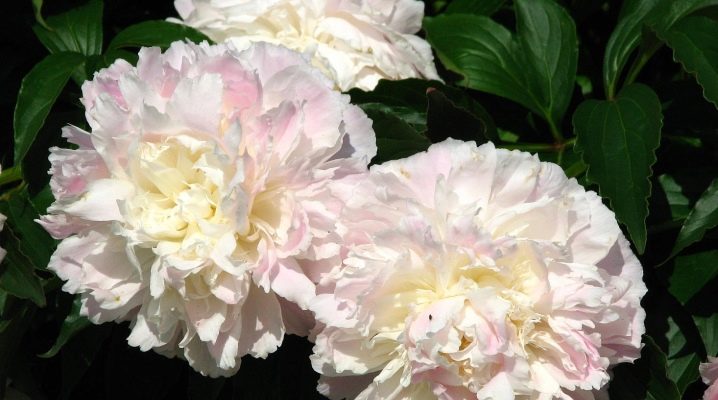
Novice gardeners usually do not dare to place some unknown "overseas" varieties on their site. The reason for this is the widespread belief that elite varieties will have to be looked after in a special way, that these plants are capricious and short-lived. And as a result, the money spent on the purchase of new items will be thrown away. This opinion is completely refuted by the peony "Shirley Temple".
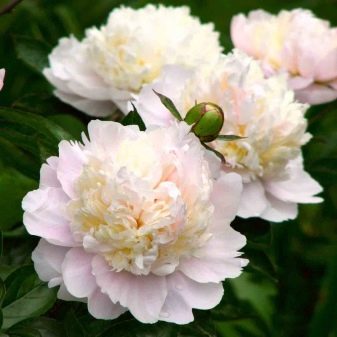

Description
The variety was developed in the United States of America in 1948. Its author is a breeder scientist Louis Smirnov. Peony got its name in honor of the Hollywood actress Shirley Temple, who became an Academy Award winner.
Shirley Temple belongs to the herbaceous peony class. Stems up to 90 centimeters high are very strong, do not bend under the weight of large double flowers, the diameter of which is about 20 cm.
The shape of the flowers is spherical, dense, in appearance they resemble roses. The similarity is enhanced by the delicate scent.
In the bud stage, the flower has a pinkish color, which, when blooming, gradually changes to snow-white. They begin to bloom at the end of May, the flowering time is always different. Leaves are dark green, delicate, very decorative. With the onset of autumn, they become crimson. Mature bushes, thanks to powerful shoots, do not need support.
The variety is characterized by increased frost resistance, easily tolerates cold snaps down to -40 degrees. Can hibernate without shelter. Possesses increased resistance to diseases and is slightly affected by pests. The place in the garden for this culture must be chosen very responsibly, since this perennial is able to grow without transplanting up to thirty years.
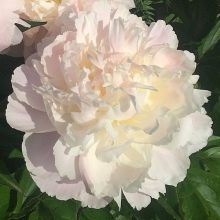
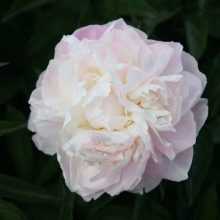
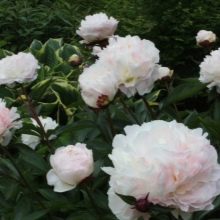
Growing features
Shirley Temple's requirements are the same as most peonies.
- Loves well-lit, open areas. It is here that he will reveal all his splendor. However, in hot weather, you will need light shelter from too bright sunlight.
- Also, do not forget that there should be no shrubs and tall trees nearby, and it is better to keep a distance of three meters to the nearest buildings, no less. Peonies are placed on a plot two meters from one another. This arrangement promotes good ventilation and prevents the appearance of diseases.
- A planting pit is prepared solid, deep, with the expectation of strongly growing roots.
- Even if the soil is rather loose, it is better to lay drainage on the bottom: gravel, crushed stone, sand or at least broken brick.
- In order to provide a young plant with nutrition for the first time, about three buckets of humus, a half-liter can of wood ash and half a glass of mineral fertilizers, which include potassium and phosphorus (for example, superphosphate, potassium sulfate), are poured. Everything is thoroughly mixed with earth.
- This crop prefers light, slightly acidic soil. Therefore, if necessary, lime is added to the soil.
In addition to the herbaceous variety, there is also the Shirley Temple tree variety. There are some differences in the way they are planted. Treelike ones are planted deeper so that the roots of the plant develop fully, but herbaceous ones, on the contrary, do not like great depth.


After the pit is fully prepared, they begin planting. The seedling is placed in the middle and covered with earth so that the upper buds are at a depth of 3-4 centimeters for the herbaceous variety, and up to 8 cm for the tree species.
The soil around the bush is slightly compacted, watered and mulched with dry humus, crushed bark, sawdust or dried grass.
Further care in the first two to three years is as follows.
- Frequent but moderate watering. For a plant, both lack of moisture and its excess are equally destructive.
- Constant loosening of the soil, is held the day after rain or watering.
- Timely weed removal.
- In autumn, after the onset of the first cold weather, the aboveground part is cut off almost to ground level.
- Despite the fact that the variety belongs to frost-resistant, it is better to cover young bushes for the winter, sprinkling a layer of humus or compost on top.
- In the spring, as soon as the threat of frost passes, the insulation is removed.
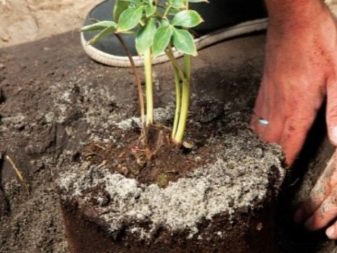

For 3-4 years, the peony blooms for the first time. From that time on, they begin to feed him. For convenience, the procedure can be combined with watering. In total, three dressings are carried out per season.
- In early spring, organic fertilizers are applied. This helps the plant to grow faster and get stronger after winter.
- The second time is fertilized before flowering, when the buds begin to swell. Here mineral fertilizers with phosphorus content will be required.
- The third feeding is carried out closer to autumn, when the faded peonies are preparing for wintering. The fertilizer must contain potassium. In no case should nitrogen be added, since the shoots will grow, and the roots will not have time to accumulate a sufficient amount of nutrients.
- After frost, the stems of plants are cut at a height of 7-8 centimeters from the surface. Adult peony bushes tolerate winter cold.



Application in design
A plant as luxurious as "Shirley Temple" deserves a place of honor in any garden area. Moreover, taking care of him is not difficult at all.
Here are some ideas for using this culture in landscape projects.
- Single or group planting on the lawn, can be framed by ground cover perennials, such as badan.
- In the middle of a large round flower bed, surrounded by undersized bright annuals with different flowering periods: petunias, asters, gerberas.
- As a lush curb along the garden path. Here gladioli, foxglove, aquilegia can serve as their "companions".
- This peony will look just as good. next to hybrid tea roses suitable shade. Choose pastel or pink colors.
Wherever this flower is planted, it will always occupy a leading position, and all the others will serve as just a background for it.
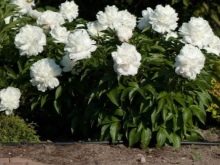
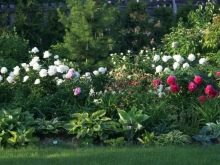
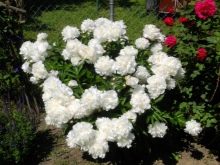
How to care for peonies, see below.







































































































The comment was sent successfully.